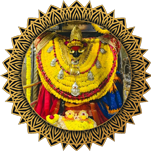

Nestled in the serene town of Vindhyachal in Mirzapur district, Uttar Pradesh, the Maa Vindhyavasini Temple stands as a beacon of spiritual solace and divine energy. Perched on the banks of the sacred River Ganga, this revered Shaktipeeth is dedicated to Goddess Vindhyavasini, an embodiment of Maa Durga. The temple attracts millions of devotees annually, drawn by its rich mythology, historical significance, and the promise of spiritual fulfillment.
The origins of Maa Vindhyavasini are deeply rooted in Hindu mythology. According to the Markandeya Purana, after slaying the demon Mahishasura, Goddess Durga chose the Vindhya mountains as her abode, earning her the name Vindhyavasini—"She who resides in the Vindhyas". This act signified the triumph of good over evil and established the region as a powerful center of divine feminine energy.
Furthermore, the Durga Saptashati narrates that the Goddess, in her Yogmaya form, was born to Nanda and Yashoda in Gokul. When Kansa attempted to kill her, she escaped and settled in the Vindhya region, further cementing the area's spiritual importance
The temple's prominence is not only mythological but also historical in nature. Ancient scriptures like the Mahabharata, Skanda Purana, and Devi Bhagavata Purana mention Vindhyachal as a significant spiritual hub. Over centuries, the temple has witnessed patronage from various dynasties, including the Guptas and the Mughals, each contributing to its architectural and cultural development.
The Maa Vindhyavasini Temple showcases traditional North Indian temple architecture. The sanctum sanctorum houses the idol of the Goddess, adorned with intricate jewelry and vibrant garments. The temple's walls are embellished with carvings depicting scenes from Hindu epics, and the spire (shikhara) rises majestically, symbolizing the ascent to the divine.
Devotees engage in various rituals and practices to seek the blessings of Maa Vindhyavasini. Daily aartis, special pujas, and the chanting of hymns create an atmosphere of devotion. The temple becomes especially vibrant during festivals like Navratri, Chaitra, and Ashwin, attracting pilgrims from across the country. During these times, the temple complex is adorned with lights and flowers, and cultural programs are organized to celebrate the Goddess's glory.
